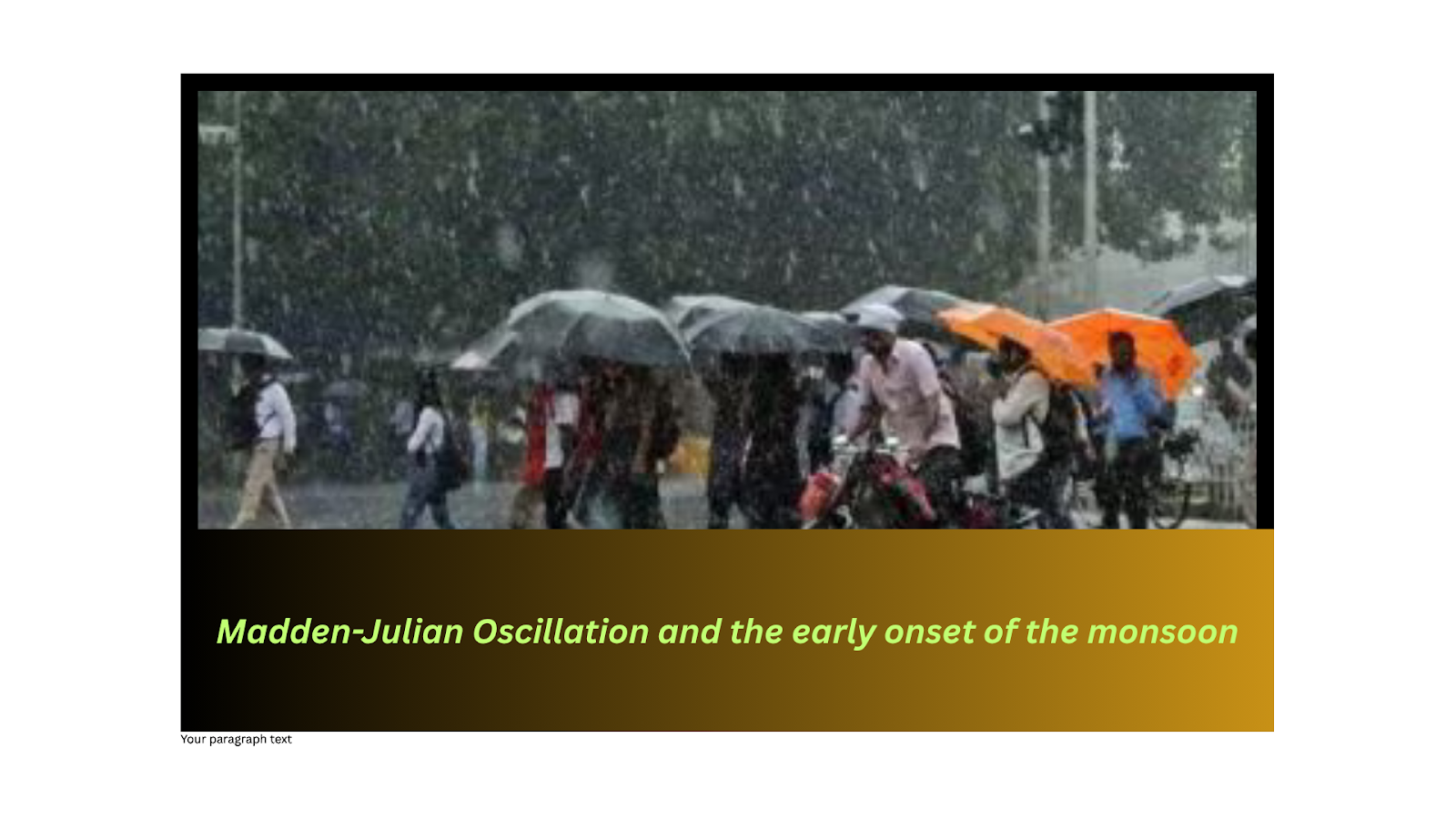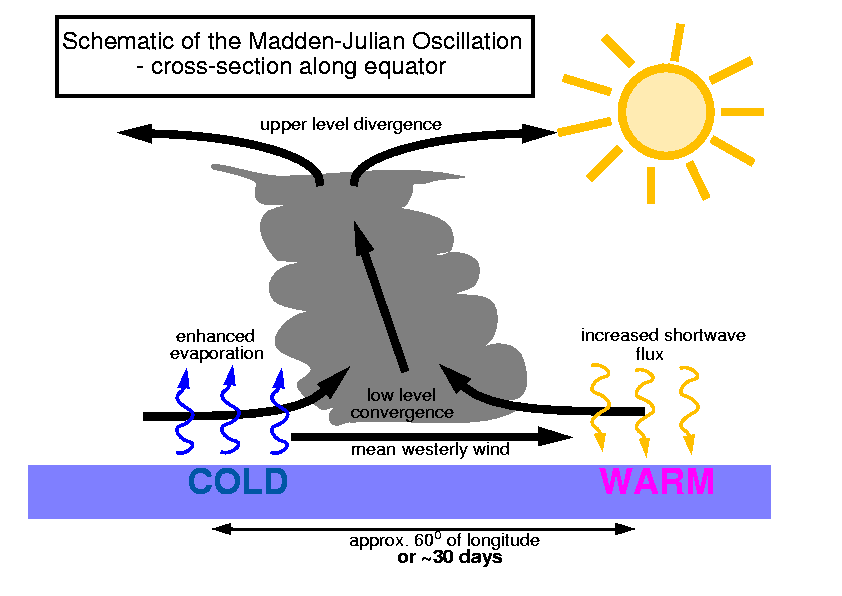Early Arrival of Southwest Monsoon 2025
Madden-Julian Oscillation and the early onset of the monsoon
Context: The India Meteorological Department (IMD) officially announced the arrival of the southwest monsoon over Kerala on May 24, 2025, marking an onset eight days earlier than the typical June 1 date.

More on News
- This year’s arrival wasn’t just ahead of schedule—it made history by reaching Mumbai on May 26, the earliest recorded monsoon onset for the city.
- While early monsoons often bring cheer across India, they don’t always guarantee a normal or surplus monsoon season.
Why Did the 2025 Monsoon Arrive Early?
- Multiple Factors: While there is no single “secret sauce” for early monsoon onset, multiple atmospheric and oceanic factors played a role in 2025’s premature arrival.
- MJO: One key player, according to the IMD, was the Madden-Julian Oscillation (MJO)—a moving band of rain clouds, winds, and low pressure that travels eastward around the equator.
What is the Madden-Julian Oscillation (MJO)?
- The MJO is a tropical weather phenomenon that cycles every 30–60 days, alternating between active and suppressed phases.
- In its active phase, the MJO enhances cloud formation and rainfall, which can contribute to monsoon development.
- When it entered Phase 4 with an amplitude greater than 1 around May 22, 2025, it significantly increased rainfall and cyclonic activity over the Indian Ocean—conditions ripe for triggering monsoon onset over Kerala.
- Historically, the MJO has been associated with strong monsoon spells.
-
- For example, in June 2015, robust MJO activity contributed to nearly three weeks of intense rainfall across India.
- The same dynamics seem to have influenced the 2025 early onset, especially when combined with other meteorological factors.

Global Warming and Climate Variability: The Bigger Picture
- Since the 1970s, studies have observed a systematic delay in monsoon onset dates, likely linked to climate regime shifts and global warming.
- The current year is already 1.2°C warmer than pre-industrial levels, riding on the back of record-breaking global temperatures in 2023–2024.
- In this context, the unusual sea surface temperature (SST) patterns in the tropical Pacific become relevant.
- The 2024 La Niña was considered a “failed” one due to persistent warm anomalies in the eastern and western Pacific, and cooler temperatures in the central region.
- While these patterns deviate from classical La Niña behaviour, they might still influence regional climate systems such as the Indian monsoon.
Is 2025’s Early Onset Similar to 2009?
- The last comparably early onset occurred in 2009, which ultimately turned into a severe drought year despite initial optimism.
- That year followed a mild El Niño and an unusually warm tropical Pacific—patterns that raised concerns about El Niño’s evolving role under global warming.
- While 2025 is currently expected to be ENSO-neutral, some climate models hint at a developing El Niño, reminiscent of 2009.
- However, it’s too early to draw direct parallels. What’s clear is that the influence of ocean heat content and SSTs in the Pacific during the onset phase could hold clues to the season’s overall performance.
Cyclones and Monsoon Dynamics: Local and Global Interplay
- Another important contributor to the early onset was pre-monsoon cyclonic activity.
- The northward pull of the monsoon trough this year was likely influenced by a low-pressure system along India’s west coast, which accelerated the monsoon’s arrival.
- Late-season cyclones, increasingly common, may also be linked to Arctic warming and shifting wind patterns over the Arabian Sea.
- At the same time, Pacific typhoons have historically delayed monsoon onset by drawing moisture away from the Indian Ocean.
- These complex teleconnections highlight the difficulty in predicting monsoon onset with precision.
Changing Patterns in Seasonal Rainfall Distribution
- Beyond the onset date, the monsoon’s intra-seasonal behaviour is undergoing shifts.
- Increasingly, meteorologists have noted mergers between the southwest and northeast monsoons in some Indian regions.
- Erratic rainfall distribution, with droughts and floods occurring simultaneously in different parts of the country, underscores the growing unpredictability.
Socio-Economic Implications
- Agricultural Impact: The early monsoon onset affects planting schedules for kharif crops, which rely heavily on monsoon rains. An early start could benefit agriculture if managed well, but risks of flooding persist.
- Disaster Management: The early and intense monsoon underscores the need for robust disaster preparedness, as seen in Kerala’s response strategies discussed by experts.
- Renewable Energy Potential: Monsoon winds, predictable through advanced forecasting, offer opportunities for wind energy generation, particularly in states like Rajasthan, supporting India’s renewable energy goals.
With climate change intensifying natural variability and complicating established patterns, improving our understanding of monsoon dynamics is more urgent than ever. While India celebrates the early rains, scientists continue the challenging task of untangling the drivers behind monsoon behaviour in a warming world.
Subscribe to our Youtube Channel for more Valuable Content – TheStudyias
Download the App to Subscribe to our Courses – Thestudyias
The Source’s Authority and Ownership of the Article is Claimed By THE STUDY IAS BY MANIKANT SINGH


